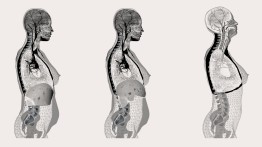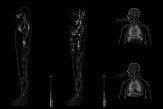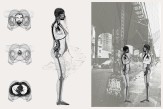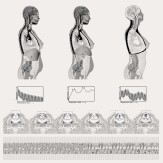MASTER OF SCIENCE IN ARCHITECTURE SPRING 2022

GRADUATE RESEARCH DESIGN STUDIO II
Diana Agrest, The Irwin S. Chanin Distinguished Professor
The Body: Corporeal boundaries, Motion, and Spaciotemporal Intersections
This studio articulates the question of the body as an object of study from a critical and transdiscursive approach. Through many possible narratives the subject of the body is opened to and articulated through various discourses and disciplines, from architecture to philosophy, history, technology, cybernetics, language, psychoanalysis, gender theory, the arts, biology, ecology, health, food, and sports, etc.
The body has a strong presence and deep roots in Western architecture theories from the texts of Renaissance readings of Vitruvius. From Alberti to Francesco di Giorgio Martino and Filarete, the body has been both a referent, a tool, and a construction in which the body (of man) is both a metaphoric and a metonymic construction having perfect proportions and harmony based on nature in whole and in part. We can fast forward to the culture of disembodiment brought about as a result of cybernetics, information, mediatization, and the development in general of virtual reality, in a world that is nothing but simulacrum and in which the body becomes, in its many forms of representation, a simulacrum itself.
In the long stretch in between there are all forms of architectural constructions of the body—from Ernst Neufert’s mechanistic Architects’ Data of 1936 to The Modulor by Le Corbusier of 1945 and 1955, or the implied control of the body in the earlier Radiant City of 1930, or through urban design as a mechanism for eradicating disease and developing healthy bodies while in the city. One could certainly say a lot about these narratives of control of the body in space, such as the body as a machine in a prevailing technocratic ideology.
One could still ask however, what body is the body in question? The question is that of difference as opposed to the universalization of an abstract (male) body. Differences of all kinds, from genetic, to cultural, historical and psychological, including questions of sex, gender, race, or ethnicity. In this context the body may be seen as it relates to questions under the general rubric of health and the many different modes in which health and the overcoming of disease and the body/machine interaction are once more enacted. Or the case of overcoming the body’s corporeal boundaries through the means of possible extensions, from those related to the sensorial and to parts of the entire body through the possibilities afforded by constantly changing and advancing technologies, including pushing the limits of the body in space, attempting to overcome gravity itself, as in athletic activities or space exploration, becoming both subject and object of the spectacle.
But this body is also affected if not completely determined by socio-political, economic, cultural, and ideological environments and enacted in diverse places and modes of action and habitation. From bodies that proudly express the marks of a culture, as the body becomes a text and gestures become a language, the body is an expression of cultural and artistic freedom relative to the occupation of space through performance, from musical expression, dance, relative to other bodies, to the bodies that bear the marks as they are subject to the effects of colonization by psychological, mental, and physiological manipulation through the politics of health and nutrition as it is clear in the historically entangled/colonization of the body by Western science and technologies. This exploration is critically developed in specific contexts where students find their own individual interests and narratives.
A first exploration was developed through readings of films in which the body and the city are protagonists in the unfolding of the film’s narrative and form.
Projects
-

Breathing and Singing: Enhanced Overtone Singing
Back
Breathing and Singing: Enhanced Overtone Singing
Xinyi Xie
In modern society, breathing remains the most primal way for humans to connect with their outside environment. In yoga, breathing is an essential condition, just as it is for life itself. As air enters the body through the nasal cavity, reaching thousands of lung alveoli, the diaphragm expands and then contracts as the air is sent backwards in a rhythmic process. It is through this process that humans, and even all other living things, are inextricably entangled with their environment.
Breathing is also central to the process of creative expression. My project attempts to explore this condition by focusing on singing. Music created by humans using their vocal and breathing apparatus, vocal cord vibrations, and the body's resonance, has been used to great effect in overtone singing, from ancient traditional societies to mid-20th century music. This project focuses on wearable devices designed to enhance overtone singing, allowing the body’s resonance to become a way for people to understand and express the culture and world around them.









